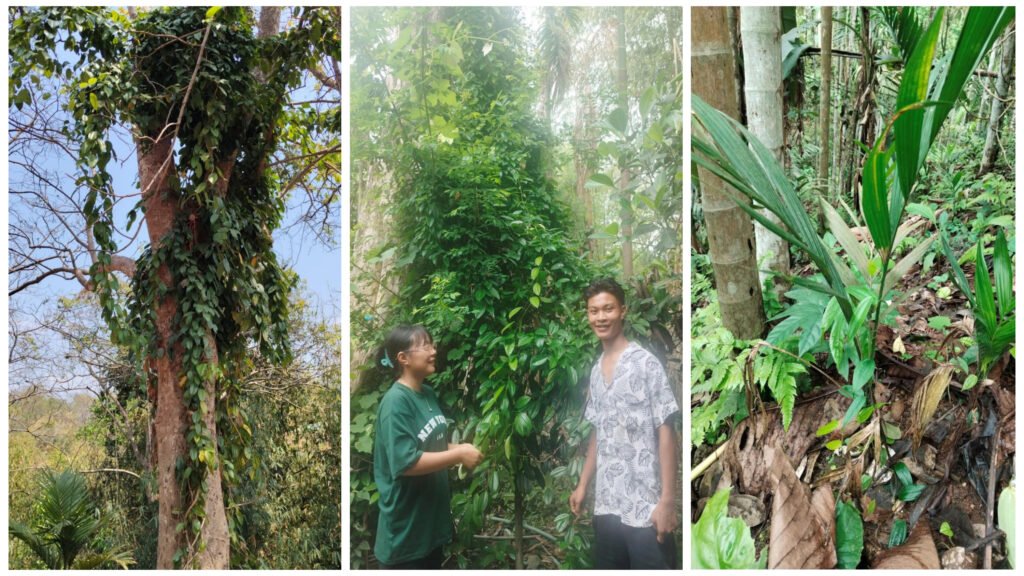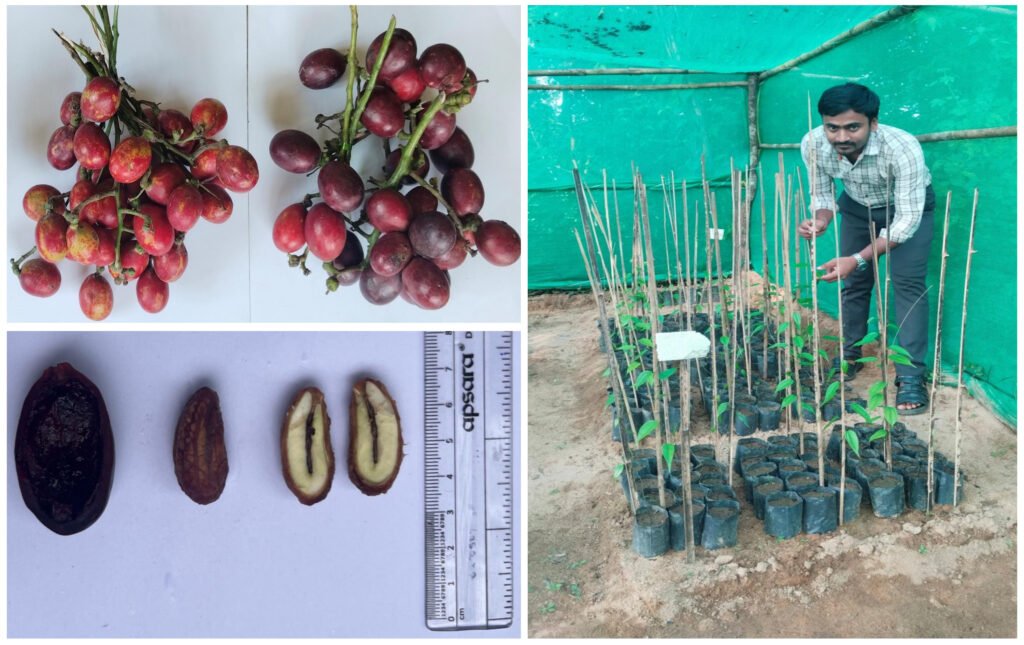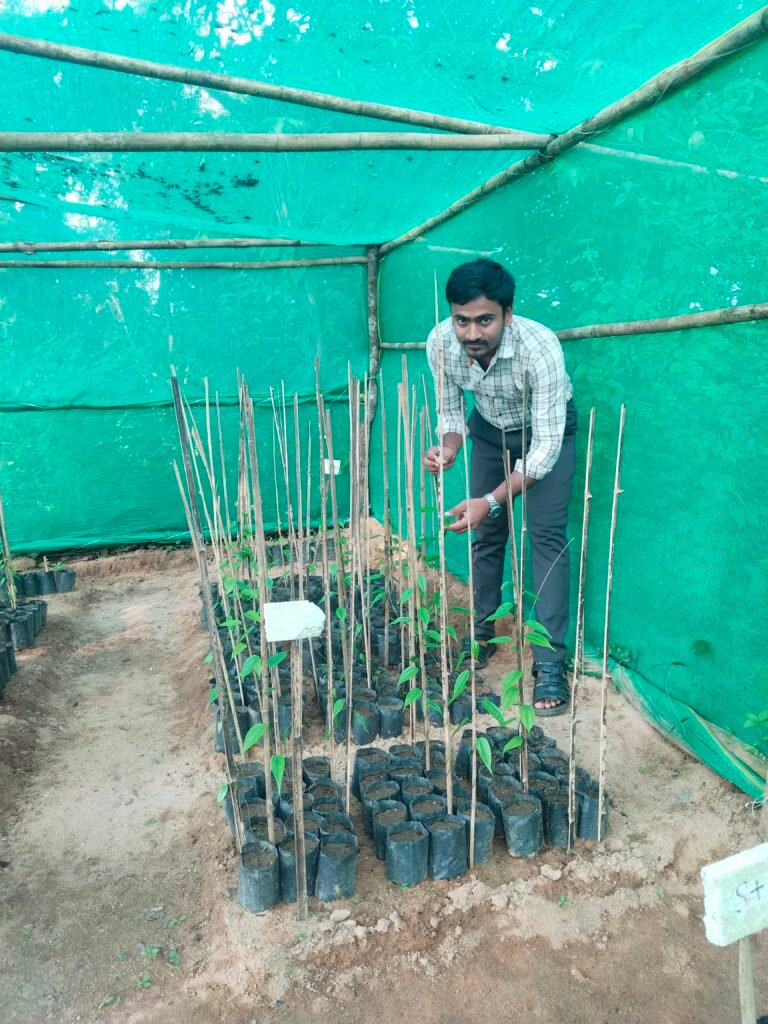Over the two years, I have observed one more unique fruit from the Tura range of Garo Hills. A bright red fruit with rich antioxidants and iron content, along with traditional wisdom that could heal ailments, color food naturally, and revitalize community livelihoods, yet it remains mostly hidden under the dense canopies of forests.
Meet the Blood Fruit, locally known as Khoon Phal (Haematocarpus validus). This dark red fruit grows wild in the dense tropical forests of Northeast India and the Andaman and Nicobar Islands, and is culturally and medicinally valued by ethnic communities for its various health benefits. Despite its numerous potentials, this fruit is very close to becoming forgotten due to being underutilized, under-researched, and under-conserved. Once it was strongly associated with wild edible fruits like Burmese Grape (Baccaurea ramiflora), Jalpai (Ealeocarpus serratus), and Longon (Dimocarpus longan), now, it is urging support for its survival due to indiscriminate deforestation for agricultural land expansion, particularly, arecanut monocropping.

To read more about Blood Fruit, click here http://dx.doi.org/10.21203/rs.3.rs-6829029/v1
Let’s explore the beautiful journey of this forest gem: its ecology, uses, challenges, and why it’s time we bring this Blood fruit into the mainstream.
What is Blood Fruit?
Blood fruit is a woody climber belonging to the Menispermaceae family. Its name is derived from the Greek words Haem (blood) and Carpus (fruit) due to its red blood pulp.
In India, this species is naturally distributed in Meghalaya, Tripura, Mizoram, and the Andaman & Nicobar Islands in both wild and semi-wild form. Traditionally collected from the forest as non-timber forest produce (NFTP) by ethnic groups in India, Bangladesh, and parts of Southeast Asia, the fruit has long been used in ethno-medicine, traditional cuisine, and rituals.
Nutritional treasure house
If food could be medicine, blood fruit would be a leading prescription. Its rich blood red color is due to the presence of anthocyanins, potent antioxidants that fight inflammation, slow aging, and protect the heart.
Scientific studies have revealed its rich nutritional profile:
| Nutrients | Amount per 100 g (Dry weight) |
| Iron | 57.29 mg |
| Potassium | 1740–1890 mg |
| Vitamin C | 13.15–17.94 mg |
| Choline | 197.81 mg |
| Protein | 7.60 % |
| Total Sugar | 7.14 5 % |
| Beta-carotene | 132.8 IU |
Blood fruit is rich in iron (Fe), which is crucial for treating anemia, one of the leading nutritional deficiencies in women of rural India. The other biochemical compounds, such as quinic acid, sinomenine, and phenolics, act as anti-inflammatory, hepatoprotective (liver-protecting), and neuroprotective. Many studies reported that the nutritional content of blood fruit is higher than many commercial fruits like mango, jackfruit, and citrus. It has a high K (1740–1890 mg/100g), which is higher than apples, citrus, jackfruit, and mango. The vitamin C content (13.15–17.94 mg/100g), and carotenoids (18.47 mg/100g) are also higher in blood fruit, promoting immunity, supporting vision, cell protection, and skin health. It also has high antioxidant capacity and unique phytochemicals like quinic acid, anthocyanins, and choline.
A Silent Guardian of Forest Biodiversity
Beyond its health benefits, Blood fruit plays an important yet powerful environmental role. It flourishes even in natural virgin forest areas, often climbing over by twining around native trees such as banyan, burmese grape, jackfruit, and Schima wallichii. Its seasonal bright red fruits attract a variety of frugivorous birds and animals, playing a key role in the forest dynamics.
It indirectly preserves forest biodiversity by supporting the forest food chain. Unfortunately, the indiscriminate deforestation and monoculture plantations (like areca nut), this ecological role is diminishing.
Traditional Wisdom, Scientific Backing
In South Asia, indigenous communities like the Garo of Meghalaya, Chakma and Marma of Chittagong, and tribal groups (Great Andamanese, Jarawa, and Nicobaris) of the Andaman Islands have been using blood fruit as a food, traditional medicine, and natural dye.
- To cure anaemia: Thanks to its iron richness.
- For jaundice and liver problems: through its shoots and quinic acid.
- To heal skin itching, use root extracts.
- As a natural dye and food colorant, a sustainable alternative to synthetic chemicals.
Every part of the plant is utilized (fruits, seeds, roots, and leaves) to showcase the deep treasure of indigenous knowledge.
Transforming wild edibles into market delights
Its unique, blended sweet and sour taste carved a space in traditional and modern culinary uses:
- Raw Consumption: Directly eaten raw.
- Juices & Beverages: Refreshing and medicinal.
- Pickles, Chutneys & Jams: Especially in Tripura and Bangladesh.
- Natural Wine & Fermented Drinks: Popular among the Garo people of Meghalaya.
- Rice Cakes & Desserts: Common in the Chittagong region of Bangladesh.
Despite all its culinary and medicinal benefits, it’s hardly seen in urban or mainstream markets. A 10–15 fruit cluster in Meghalaya sells for around ₹100 in local markets, indicating its high demand but limited availability.
Bringing Blood Fruit to the Backyards: The Agroforestry Vision
Blood fruit thrives in biodiverse environments with minimal maintenance, making it a resilient species. It can be spatially and temporally fit well into agroforestry as an ideal candidate, like black pepper, vanilla, and betel vine.
Once blood fruit was naturally climbing over the native trees, later with arecanut crop are now it striving hard to find climbing support due to intense and commercial agricultural practices. In some parts of the Garo hills, we can find blood fruit wrapping arecanut in an organic, natural farming approach mimicking the natural forest. Arecanut is offering shade, structure, and soil health. Some of the examples for agroforestry systems are: Blood fruit + Areca nut + Native trees, or Blood fruit + Bamboo + Pineapple.
This climber is an ideal candidate for sustainable, climate-resilient farming in the hill region due to its resilience to drought, pests, and poor soils.
For more innovative information, https://whereagroforestrymeetsagriculture.com/connecting-tree-canopies-agroforestry-gibbon-corridors-to-conserve-meghalayas-three-intricate-endemic-endangered-species-2/
Why Is It Still Underutilized?
Despite its numerous benefits, blood fruit suffers from:
- Lack of awareness among farmers and consumers.
- No standardized cultivation practices.
- Lack of domestication.
- Recalcitrant seeds and slow regeneration capacity.
- Perishable nature: Spoiling within 4-5 days.
- Large seeds and low pulp content make it less suitable for processing.
Also, its dioecious nature (separate male and female plants) requires careful planning and spacing in cultivation. Research on vegetative propagation (cuttings, grafting) is scarce, and the lack of breeding efforts for fruit quality improvement, like seedless or high-pulp varieties, is still absent.
A Call for Conservation
Haematocarpus validus is not officially endangered, but many researchers and field observations list it as vulnerable or even threatened in parts of Northeast India and the Andaman Islands.
Key reasons include:
- Loss of habitat due to jhum (shifting) cultivation.
- Unsustainable harvesting without regeneration.
- Fragmented forest patches and poor seed dispersal.
- Climate shifts affecting its fruiting cycle.
Now, it is time for community engagement in conservation, in-situ efforts in forests, and ex-situ propagation in home gardens and farms to ensure this plant doesn’t slip into extinction.

The Way Forward: What Needs to Be Done?
To revive blood fruit and place it on the national (and global) food map, we must act on several fronts:
- Research & Domestication: a) Develop standardized propagation techniques. b) Breeding efforts are being made to improve pulp content and reduce seed size. c) Develop a vegetative propagation method to shorten the time to maturity
- Value Addition & Marketing: a) Making processed products such as jams, juices, and wines. b) Promoting blood fruit as a natural colorant and superfruit. c) Linking it with government schemes like ODOP (One District One Product).
- Integration into Agroforestry: a) Preliminary research to identify compatible tree species for multistorey cropping. b) Studies on growth performance, economic viability, and compatibility with other crops. c) Document success stories from the Andaman Islands, Meghalaya, Tripura, and beyond.
- Community Involvement: a) Integrating local wisdom in conservation programs. b) Setting up of cooperatives or FPOs (Farmer Producer Organizations).
- Awareness & Education: a) Conducting training and workshops for farmers, SHGs, and NGOs. b) Running awareness campaigns showcasing its nutritional, medicinal, ecological, and economic potential.
In this rat race world, we are running behind ready-to-eat, fast foods, and so-called exotic superfruits. It is crucial to look into our forests, traditions, and forgotten foods. Blood fruit is not just a climber on a tree; it’s a symbol of cultural significance, ecological balance, tribal resilience, and health in harmony with nature.
Let us rediscover and revitalize this forest gem now.

Let’s bring Blood fruit from wild to the world, not just by cultivating it, but by growing with it.
Dinesha S & Shridevi B. Teli

